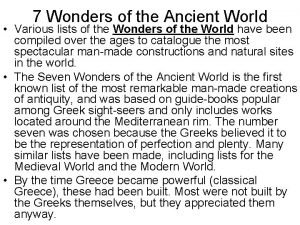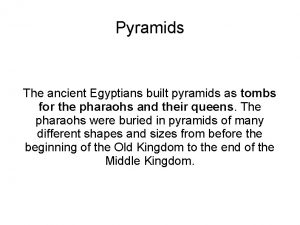Architectural Wonders Of The Ancient World The Pyramids



















- Slides: 19

Architectural Wonders Of The Ancient World

The Pyramids ' Egypt No list of the greatest structures of the ancient world would be complete without a mention of the famous Pyramids in Egypt. The Pyramid of Djoser, the oldest of the Pyramids, is estimated to have been built around the year 2630 B. C. Still today, experts have not been able to come up with a solid conclusion to explain how the ancient Egyptians built these perfectly aligned buildings using nothing but physical strength. It is presumed that as many as 100, 000 slaves worked over the years to build these immense, mysterious tombs, which are still considered one of the Seven Wonders of the World. Built without the machinery and modern technology we have come to depend on today, these ancient landmarks are nothing short of impressive.

The Roman Aqueducts ' Italy The aqueducts were constructed by the ancient Romans around 145 B. C. and were used to bring in water for the Roman Empire. The really fascinating part? The aqueducts work on gravity alone, meaning that the design is what allowed the water to be siphoned. This is one of the earliest examples of engineering and quite an impressive one at that, especially considering the lack of resources available at the time. The aqueducts still stand intact today. Many were long lost and forgotten, taken over by shrubs and vines, but many are still visible in the same form they were thousands of years ago.

El Kasneh Petra, Jordan Known as the Treasury at Petra and carved into rosecoloured stone, this rock façade is one of the most ornate architectural wonders of the ancient world. Originally built as a crypt around the first century A. D. , the sandstone carving is reminiscent of Greek architecture from that time period. What makes it so impressive, even today, is the intricate detail work that has, for the most part, remained intact. There are several legends surrounding the reason for its construction, ranging from theories about it being a treasury for the Egyptian Pharaoh during the time of Moses, to it being a hiding spot for thieves and pirates to stash their stolen goods. Whatever the reason for its construction, it's architectural beauty is indisputable.

Chand Baori ' India According to the legend in the village of Abhaneri in Rajasthan, India, where the Chand Baori stepwell lies, ghosts built it around the 10 th century. As farfetched as that may seem, there don't seem to be any other explanations on the table as to how this perfectly designed stepwell came to be. Around 900 AD, King Chanda had it built to solve the area's drought problem. Roughly 13 stories high, dug into a V-shape nearly 100 feet below the earth's surface, with an estimated 3, 500 perfectly levelled steps, King Chanda devoted it to the Goddess of Joy and Happiness, Hashat Mata, upon its completion. Details on its impressive construction remain a mystery.

Megalithic Temples ' Malta The Megalithic Temples of Malta ' 11 to be exact 'are prehistoric monumentsbuilt between the years 3000 B. C. and 700 B. C. During this period, temple building was extremely important and each of these structures is an improvement upon the one preceding it. Some archaeologists believe the temples' which have been described as theoldest freestanding buildings in the world'were built to worship specific gods and many are still impressed by the intricacies each bears, given the lack of adequate building tools at the time.

Leshan Giant Buddha ' China Around the year 713 A. D. , construction began on the Leshan Giant Buddha in Sichuan, China. The construction of the monument, the largest statue of the pre-modern world, was halted for about 70 years due to funding issues. The project was resumed and completed by the year 803 A. D. At the time, the raging rivers ' which now calmly lay at the statue's feet'made it difficult for ships to pass, hence why a Chinese monk sought to have the statue created. He felt the statue in Buddha's honour would get the water to calm down. In the end, so much stone was carved out of the mountain to make the statue that when it fell into the water and stayed there, it actually did make the turbulent waters calmer and easier for ships to pass through. Built entirely by hand, this giant statue remains the largest statue of Buddha known to man.

The Great Wall of China Construction on the Great Wall of China began as early as the 7 th century B. C. and was continued by several different Chinese dynasties to protect the borders of the country from intrusion. It took hundreds of years to complete the Great Wall, which is over 21, 000 kilometers long. Millions of prisoners were forced to work on the wall and it is believed that nearly one million lives were lost during its construction. Made of stone, brick and wood, this 2, 000 -year-old wall still stands today, attracting millions of visitors annually.

Sacsaywaman ' Peru A stone fortress, Sacsaywaman is located in Cusco, Peru, once the capital of the Inca Empire. Considering that some of the stones used to make up this fortress weigh as much 200 tons, it's mindboggling to think this structure was built even before the Inca Empire, around 900 A. D. to 1200 A. D. Even more impressive is the fact that stones were intricately cut to fit into one another very tightly, keeping the walls up for centuries without the use of mortar or grout of any kind. Sacsaywaman is believed to have been built by people who carried the stones from a quarry several miles away. Each stone is said to have been tied to rope, and pulled to its final destination. The masonry was so impressive that when the Spanish invaded and took over Cusco in the mid 1500 s, they thought Sacsaywaman must have been built by demons and ordered it to be taken down. Much of it remains intact today, however, since many of the stones were simply too heavy for the Spaniards to move.

The Parthenon - Greece One of the most popular attractions in Greece, the Parthenon was built around 438 B. C. Although it served as a temple at certain points in history, it was originally built as a fortress and was also converted into a Christian church at some point, too. The construction of this immense building, most commonly known as the Temple of Athena, is extremely impressive when you consider the fact that all the stones used to build it were carried and laid in place by hand. The architecture of the Parthenon is impressive, as well. In building several tapered columns, the entire temple looks straighter than it actually is, a clever illusion used by the Parthenon's designers that still fools the eyes of many today.

Borobudur - Indonesia This 9 th century Buddhist temple is the largest in the world. A UNESCO World Heritage Site, this remarkable landmark contains over 500 Buddha statues, and some very ornate and striking designs. Completed around the year 825 A. D. , Borobudur is still a popular pilgrimage site. The immense temple was actually lost under volcanic ash, until it was rediscovered and excavated in the early 1800 s. How it disappeared still remains a mystery.

Leshan Giant Buddha, Sichuan, China The famous 71 meters (233 feet) tall statue is carved out of a cliff face. It shows a seated Buddha with his hands on his knees. This statue is the tallest statue of the Buddha and the shoulders are 28 meters wide. The smallest toenail can easily seat a person and the 7 meters wide ear can accommodate two people. The head of the Leshan Buddha is 14. 7 meters tall and 10 meters wide and is covered with 1, 021 buns of curly hair.

Derinkuyu's Massive, Ancient Underground City The city was probably used as a giant bunker to protect its inhabitants from either war or natural disaster, but its architects were clearly determined to make it the most comfortable doomsday bunker ever. It had access to fresh flowing water -- the wells were not connected with the surface to prevent poisoning by crafty land dwellers. It also has individual quarters, shops, communal rooms, tombs, arsenals, livestock, and escape routes. There's even a school, complete with a study room.

The Ancient Marib Dam Worked for 1, 000 Years The dam, which was cheated out of being one of the "official" Seven Wonders of the World, was regarded one of the greatest feats of engineering of the pre-industrial age. After all, building a dam isn't like putting a bunch of stone monoliths in a big circle. You have to have canals, gates, sluices, and spillways, and the whole thing has to be waterproof, or else everybody living on the wrong side of it might wake up drowned one morning.

Pumapunku Is Made of Bizarrely Complex Interlocking Stones Pumapunku is a city built by the Tiwanaku people of ancient Bolivia. What sets it apart from just any old ancient city is the almost weird precision of the stonework that would make modern builders envious. Using crude technology, they pioneered a kind of construction that used hundreds of large, identical building blocks to make buildings like you and I would make a house out of LEGO. To make cuts as straight and precise today, we'd reach for some kind of laser cutter. They used chisels and rulers

Gobekli Tepe Was Built Before Humans Knew How to Grow Food Surveyors in Turkey found an ancient buried complex composed of huge stone pillars arranged in a circle like Stonehenge, some of them 30 feet tall. What really knocked the monocles out of their eyes, however, was that this was much older than Stonehenge. . . 6, 000 years older.

Conical Tower, Great Zimbabwe - 11 -16 th Century BC The Great Enclosure is composed of an inner wall, encircling a series of structures and a younger outer wall. The Conical Tower, 5. 5 m (18 ft) in diameter and 9 m (30 ft) high, was constructed between the two walls.

Ishtar Gate, Babylon - 605 -563 BC Dedicated to the Babylonian goddess Ishtar, the gate was constructed using glazed brick with alternating rows of bas-relief dragons and bulls, symbolizing the gods Marduk and Adad respectively. The roof and doors of the gate were of cedar, according to the dedication plaque. The gate was covered in lapis lazuli, a deep-blue semi-precious stone that was revered in antiquity due to its vibrancy. These blue glazed bricks would have given the façade a jewel-like shine.

Achaemenid Tombs, Naksh-Rutsam, Iran - 5 th Century BC Naqsh-e Rustam is an ancient necropolis located about 12 km northwest of Persepolis, in Fars Province, Iran, with a group of ancient Iranian rock reliefs cut into the cliff, from both the Achaemenid and Sassanid periods. It lies a few hundred meters from Naqsh-e Rajab, with a further group of Sassanid reliefs. Four tombs belonging to Achaemenid kings are carved out of the rock face at a considerable height above the ground. The tombs are locally known as the Persian crosses, after the shape of the facades of the tombs. The entrance to each tomb is at the center of each cross, which opens onto to a small chamber, where the king lay in a sarcophagus.
 7 woders of the world
7 woders of the world 7 wonders of the ancient world
7 wonders of the ancient world Ancient wonders map
Ancient wonders map 7 wonders of the ancient world names
7 wonders of the ancient world names 7 wonders of the ancient world map
7 wonders of the ancient world map 7 wonders of ancient greece
7 wonders of ancient greece 7 wonders of the world halong bay
7 wonders of the world halong bay Old 7 wonders of the world
Old 7 wonders of the world 7 wonders of the world
7 wonders of the world Jocelyn vazquez
Jocelyn vazquez What are folktale elements
What are folktale elements Seven wonders of the world 2012
Seven wonders of the world 2012 Dali seven wonders
Dali seven wonders Wonders of the world
Wonders of the world 7 wonders of america
7 wonders of america Means of communication in ancient times
Means of communication in ancient times Ancient india vs ancient china
Ancient india vs ancient china History alive the ancient world chapter 8
History alive the ancient world chapter 8 Clothing in the ancient world
Clothing in the ancient world History alive the ancient world chapter 14
History alive the ancient world chapter 14



































